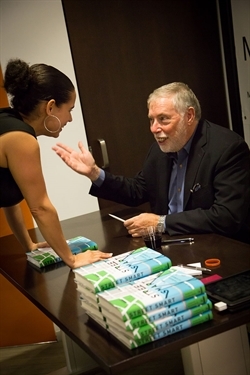
Tricia Scully
I talked with Sam Schwartz about cities and his new book Street Smart at MPC's recent Urban Think & Drink featuring the author.
It’s not that he hates cars, or sees no place for them in the city of the future, but nationally renowned transportation planner Sam Schwartz believes things are changing. Younger Americans are choosing to live in urban areas with access to mass transit where owning a car is not a requirement. Though he may get push back from some members of the boomer and X generations, he wins them over when explaining that if they want their grown children to stay close when they become adults, cities need to change their way of doing business. Unfortunately, over the last 100 years in America, a combination of poor car-centric policies and inflexible decision makers has created communities that do not entice the next generation to stay.
Schwartz covers these topics and many more in his very readable book Street Smart, and he discussed them with a standing-room-only crowd at Metropolitan Planning Council (MPC) on Thursday, Oct. 22. His presentation was part one of a trilogy of like-minded urbanists—learn more and sign up on our website.
What Sam Schwartz sees
In 2004, four years before one of the country’s worst depressions, a change in Americans' driving habits was quietly taking place and initially noticed by no one. For the first time in decades, the number of miles individuals drove per year began a sustained drop. Ten years later that drop continues. The Millennial generation has contributed mightily to that trend, with fewer members of that generation than previous ones immediately getting their license upon turning 16. Simultaneously, 16-34 year olds took 24 percent more bicycle trips and increased their miles on transit by 40 percent. Not surprisingly, a greater percentage of this age group, compared to those 30 and over, live in urban areas where not owning a car is feasible and transit and bike options are plentiful.
Schwartz explains these trends with several theories including that millennials are shopping more online, reducing trips to the store; replacing some in-person meetings with friends with online social interaction; and rebelling against the angst they observed from the back seat as their parents fought traffic daily and didn’t hide their disgust. Unfortunately, it will take a lot of effort to reverse the policies of the past in many communities so that urban areas can be attractive to the new urbanists.
How it happened
Schwartz cites evidence as far back as Chicago’s 1909 Burnham Plan as responsible for beginning the trends that turned our cities over to the car. In that landmark planning document Daniel Burnham calls for the creation of “roads for automobility.” But significant damage was done in 1956 with the creation of the Highway Trust Fund that offered up to 90 percent of the cost for the construction of new roads. What mayor or governor would give up the opportunity to cut a ribbon over a shiny stretch of pavement for only ten percent of the cost?
This single policy helped turn once-vibrant inner-city neighborhoods into on and off ramps as new highways were cut through center cities across America. Where children once played stickball in the street, they now dodge speeding cars and semi-trucks.
Then there were the people responsible for making decisions about how to allocate precious public space. These traffic engineers were so enamored with the automobile that all other modes became secondary. Take for example the engineer who wanted to “modernize” the Brooklyn Bridge by replacing the trolley tracks with more lanes for cars. Before this “improvement” the bridge carried 400,000 people a day. After the dollars were spent, only 170,000 were able to cross by car. The “improvement” drastically reduced the functionality of the bridge.
What we can do about it

Tricia Scully
Sam Schwartz signs books after talking to the standing-room-only audience at MPC.
There is much work to do to overcome the ill effects of these past policies and practices so that cities can evolve to meet the demands of millennials (and some of those older Americans that share their desires—but that’s another blog post). The good news is conversations are well underway in the Chicago region and elsewhere.
MPC is doing its part by promoting transit oriented development to cater to those who are seeking a lifestyle less wedded to the car and with more choices for mobility. Our Grow Chicago effort could help Chicago meet the growing demand brought on by these trends and help us rebound from stagnant growth over the past decade, providing today’s children an attractive choice closer to mom and dad.
This Urban Think & Drink was part one of a trilogy of like-minded urbanists, with part two coming on Tuesday, Nov. 10, when Chicago’s former transportation commissioner, Gabe Klein, speaks on his book, Startup City. Early next year, another enlightened New York City transportation commissioner, Janette Sadik-Khan, will address her book, Street Fight, for part three of the series. Please visit MPC’s website to sign up for these and other events.